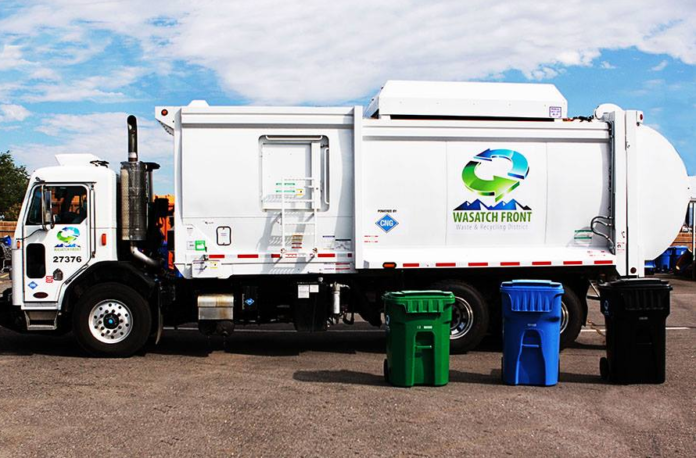Aiming to reduce vehicle emissions and promote sustainability in the Salt Lake Valley, the Wasatch Front Waste & Recycling District (WFWRD) in Utah has fully transitioned its residential collection truck fleet away from diesel fuel to be powered, instead, by compressed natural gas (CNG).
Serving the unincorporated areas of Salt Lake County and the cities of Taylorsville, Cottonwood Heights, Holladay, Herriman, and portions of Murray and Sandy, the WFWRD currently operates 46 residential side-load collection trucks and two front loaders that, as of August 2016, all run on natural gas fuel.
As noted, the trucks are all built on the Peterbilt 320 chassis, with the majority featuring 11.9-liter ISX-G Cummins motors and either Agility or NextGen CNG systems.
According to Pam Roberts, executive director of the WFWRD, the company chose to shift to CNG despite the vehicles’ higher price tag in order to dramatically reduce greenhouse-gas emissions and to save on fuel costs over the long term.
“We started the transition to CNG in [December] 2011 because we wanted to do the right thing for our environment and save money for the residents we serve,” she says. “It was quite a commitment, since CNG garbage trucks cost $30,000 more than diesel trucks. We definitely took into account that garbage trucks generally get 2 miles per gallon, no matter what type of fuel we use.”
The company saw a return on investment quickly, making up that $30,000 per truck within just three years.
“Our trucks are on a 51-month replacement schedule, so the investment has been well worth it,” she adds.
Well worth it, indeed. In fact, the WFWRD estimates it saved a whopping total of $700,000 in fuel costs over the course of the five-year transition, helping to absorb other increased inflationary costs and to maintain low rates for the residents it serves.
Roberts says the emissions-reduction benefits from the shift have already proven to be noteworthy. Emitting 20% to 29% fewer greenhouse-gas emissions than comparable gasoline or diesel vehicles, the new CNG vehicles enabled the WFWRD to cut an estimated 4,000 tons of carbon dioxide from the atmosphere.
As for refueling, the waste company says it has contract agreements with the Salt Lake County government fleet for both fueling and maintenance.
The WFWRD primarily fills up at the county fleet division’s Clean Energy time-fill station, where the trucks refuel overnight. The company also has access to the county’s fast-fill option if necessary and occasionally uses other private refueling sites, as well.
Although the company does not currently employ any other alternative fuel vehicles, the WFWRD has taken several steps over the past few years to improve efficiencies and explore sustainable options. In 2009, the waste and recycling company began using biodiesel fuel for its area clean-up vehicles.
In 2013, two years into the company’s CNG shift, the WFWRD was awarded a $79,000 grant from the Utah Division of Environmental Quality to help fund the CNG truck purchases. In that year, the WFWRD bought 11 CNG trucks, and by the end of 2014, it had expanded to a fleet of 25.
Over the course of the transition, Roberts says she has seen an overwhelmingly positive response from community partners, employees and customers alike, noting that the industry, on the whole, is becoming increasingly environmentally conscious.
As a result, she explains, a variety of “green” programs are taking hold across the sector, including the WFWRD’s own Green Waste program.
Launched in March 2014, the subscription-based Green Waste program helps divert green waste – including yard and lawn trimmings and fruit and vegetable scraps – from landfills to, instead, be processed into mulch, which can be purchased for use from the Salt Lake Valley and Trans-Jordan landfills.
This program works to benefit both the company and the environment, seeing as 1) separating green waste into its own containers eliminates recycling load contamination, and 2) diverting organics from the landfill conserves natural resources and prevents methane buildup.
The WFWRD has been proudly promoting its CNG vehicle fleet and Green Waste program since their inception. Click here to check out local television coverage of Wasatch’s CNG trucks.






